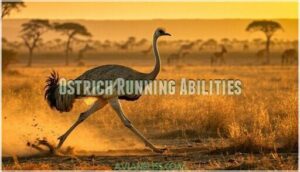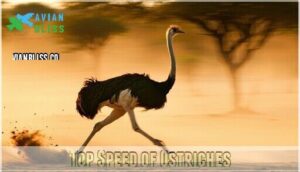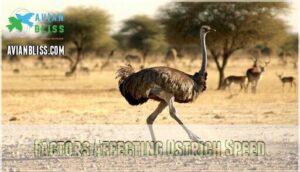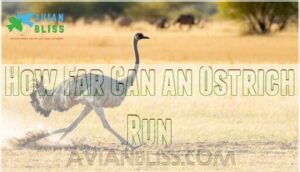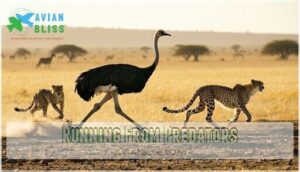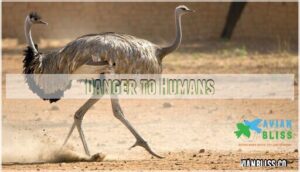This site is supported by our readers. We may earn a commission, at no cost to you, if you purchase through links.

In terms of speed, they can run up to 43 miles per hour (about 70 kilometers per hour), making them the fastest two-legged animals on Earth.
Their long, powerful legs also help them sprint and cover up to 16 feet in a single stride. That’s like skipping over a small car!
They’re built for endurance, too, capable of maintaining around 30 mph for longer distances. While they can’t fly, they more than make up for it with their running skills—an impressive adaptation for escaping predators in their open savanna homes.
Table Of Contents
- Key Takeaways
- Ostrich Running Abilities
- Top Speed of Ostriches
- Fastest Animals in The World
- Factors Affecting Ostrich Speed
- How Far Can an Ostrich Run
- Ostrich Predators and Defense Mechanisms
- Interaction With Humans
- Safety Precautions When Ostriches Are Present
- Ostrich Habitat and Diet Impact on Speed
- Ostrich Conservation Status and Speed
- Frequently Asked Questions (FAQs)
- What is the fastest ostrich ever recorded?
- Can ostrich outrun cheetah?
- Can a person outrun an ostrich?
- How fast do ostriches run?
- How do ostriches speed up?
- Are ostriches the fastest running bird?
- Are ostriches fast?
- Are ostriches the fastest animals on land?
- How many feet can an ostrich stretch?
- Can an ostrich run 70 mph?
- Conclusion
Key Takeaways
- Ostriches are the fastest two-legged animals, reaching speeds of up to 43 mph with strides as long as 16 feet.
- They’re built for endurance, maintaining speeds of 30–38 mph for over 30 minutes, making them marathoners of the bird world.
- Their powerful legs, springy tendons, and aerodynamic anatomy let them escape predators with ease.
- While cheetahs are faster sprinters, ostriches excel at stamina, outlasting most animals over long distances.
Ostrich Running Abilities
In the context of running, ostriches are nature’s speed champions, capable of sprinting up to 43 miles per hour with strides as long as 16 feet.
Capable of reaching 43 mph with 16-foot strides, ostriches dominate the savanna as nature’s unrivaled speed champions.
Their powerful legs and unique anatomy let them maintain impressive speeds over long distances, leaving most predators—and even humans—in the dust.
Speed and Endurance
The ostrich is a true speedster, blending power and endurance.
It reaches up to 45 mph in sprints and maintains 30-38 mph for over 30 minutes! Here’s what fuels its title as the fastest bird:
- Sustained ostrich speed minimizes energy use.
- Strides cover 5 meters each.
- Adapted for distance running on open plains.
- Marathon time comparison: 40 minutes!
Their excellent eyesight helps them spot predators.
Leg Structure
Think of their legs as nature’s turbo boosters.
With elastic tendons storing energy like springs, each stride maximizes speed and efficiency.
Their bones, dense yet strong, provide unmatched stability, while muscle placement close to the body boosts tendon strength for faster movement.
Even their feet contribute, resembling claws to maintain traction and balance.
Here’s a quick breakdown:
| Key Feature | Role in Speed |
|---|---|
| Elastic Tendons | Store energy |
| Dense Bones | Provide stability |
| Clawed Feet | Boost traction |
| Long Legs | Extend stride length |
| Muscle Placement | Enhances leg movement |
Biomechanical Strategies
Achieving incredible ostrich running speeds relies on smart biomechanics.
Their elastic legs store energy like springs, while powerful leg muscles drive each stride, reaching impressive lengths.
Wings act like stabilizers, keeping balance during sprints.
With a low, centered gravity, every motion feels effortless.
Here’s how they master running:
- Spring-like tendons store energy.
- Muscles power long strides.
- Wings stabilize at speed.
- Balanced body guarantees control.
Top Speed of Ostriches
In terms of speed, these birds are built to impress.
With peak velocities reaching an incredible 45 mph, ostriches own the title of the fastest running bird.
Their legs work like coiled springs, storing energy that lets them cover ground with long, powerful strides.
Measuring speed and efficiency, ostriches use less energy for running than most other animals, a true evolutionary advantage.
Imagine running faster than a speeding car in a school zone—that’s how fast ostriches go!
Their speed consistency is just as impressive, maintaining 30 mph for longer distances.
It’s all about survival in the wild, after all.
Fastest Animals in The World
In terms of speed, you’ll find ostriches in impressive company among the fastest animals on Earth.
From cheetahs to ostriches and even human sprinters, nature’s speedsters showcase fascinating adaptations that push the limits of movement.
Ostrich Vs. Cheetah
Cheetahs may reign as speed champions, but ostriches hold their own with agility and stamina.
While cheetahs hit 75 mph in short bursts, ostriches sustain 45 mph over longer stretches.
Their running strategies differ:
- Cheetah Speed: Built for explosive sprints.
- Ostrich Agility: Perfected for endurance escapes.
- Predator Tactics: Cheetahs hunt; ostriches dodge.
- Wildlife Competition: The fastest bird versus the ultimate sprinter? Fascinating match-up!
Ostrich Vs. Emus
In the context of bird racing, ostriches claim the title of the fastest running bird, reaching an ostrich top speed of 45 mph.
Emus, their smaller cousins, can still hold their own with speeds up to 30 mph.
Although ostriches win the "ostrich vs emu" speed battle, both birds rely on their powerful leg anatomy for efficient locomotion.
Thanks to their long strides and streamlined bodies, ostriches dominate flat terrains, while emus excel at quick directional changes.
Whether you’re fascinated by ostrich speed or emu comparison, these flightless birds showcase incredible adaptations for survival.
Ostrich Vs. Human Sprinters
In the context of pure running speed, the ostrich makes even Olympic sprinters look slow.
With an ostrich top speed of 45 mph, this fastest running bird leaves Usain Bolt’s 27 mph record far behind.
Its powerful legs, long strides, and efficient running styles crush human limits.
Ostriches are speed machines, combining athletic comparison and evolutionary design into unmatched running performance.
Factors Affecting Ostrich Speed
You might be surprised to learn just how much an ostrich’s speed depends on its powerful legs, lightweight frame, and efficient use of energy.
Their unique anatomy and running techniques work together seamlessly, making them some of nature’s fastest endurance runners, with efficient use of energy.
Leg Strength and Power
An ostrich’s powerful legs are a marvel of nature.
They store elastic energy, helping them run fast without tiring quickly.
Their legs have large muscles and tendons, working together like springs.
Here’s why their legs are so special:
- Fast-twitch muscle fibers: Enable quick bursts of speed.
- Long stride length: Covers up to 16 feet per step.
- Unique foot structure: Acts like springs.
- Efficient muscle composition: Reduces fatigue during running.
- Inspired robot feet: Scientists mimic their design.
Aerodynamics and Wind Resistance
An ostrich’s feather streamlining and perfect body posture reduce drag, letting it cut through wind like a pro athlete.
Its physiology guarantees airflow dynamics adjust with every stride, minimizing wind impact.
Wings act like stabilizers, maintaining balance and reducing wind resistance.
Thanks to these aerodynamics, ostriches can preserve speed even when running against gusty conditions across vast and open savannahs, utilizing their unique physiology to maintain balance.
Running Techniques
Ostriches don’t just run—they master the art of speed! Their long strides, energy-efficient leg elasticity, and balance control make every step count.
With wings acting like built-in stabilizers, they glide across the savanna effortlessly.
- Stride Length: Each step can reach up to 16 feet.
- Wing Usage: Helps maintain balance during sharp turns.
- Legs: Elastic tendons minimize exertion.
How Far Can an Ostrich Run
You’d be amazed at how far an ostrich can run, pairing speed with incredible stamina.
These birds can maintain 30 mph for over 30 minutes, making them true endurance champions of the animal kingdom.
Distance Covered
In the context of covering ground, ostrich running speed is nothing short of impressive.
With strides reaching 5 meters, these birds boast long-distance running skills few can match.
At sustained speeds of 30–38 mph, they easily conquer daily mileage across their vast territories.
Their stamina allows them to navigate sprawling migration ranges and explore expansive African landscapes with remarkable ease.
If you’re curious about their unique abilities, picture an athlete combining sprinting and marathon distance endurance—a true champion of the savanna, effortlessly balancing speed and stamina.
Marathon Capabilities
Think of a marathon, but with feathers. An ostrich could outrun the fastest human sprinter and still have energy left to grab a snack.
Their marathon time is jaw-dropping—26 miles in just 35-40 minutes, thanks to their incredible stride efficiency. Want specifics? Here’s why they dominate long-distance running:
- Energy expenditure: Elastic tendons store energy, minimizing effort.
- Endurance limits: Sustained speeds of 30-38 mph for over 30 minutes are routine.
- Environmental factors: Adapted for arid landscapes, they thrive where speed means survival.
It’s no contest—these birds are marathon pros.
Ostrich Predators and Defense Mechanisms
When predators like lions or cheetahs show up, ostriches rely on their incredible speed to escape danger, reaching up to 43 mph in a flash.
If running’s not enough, they’ll use their powerful legs and sharp claws to deliver kicks strong enough to seriously injure or kill attackers, which showcases their powerful defense mechanism.
Running From Predators
Spotting danger from miles away thanks to their keen eyesight, ostriches rely on speed as their ultimate survival strategy.
With powerful legs designed for predator evasion, they can soar across the African plains, leaving lions and other predators in the dust over long distances.
Their long necks serve as periscopes, scanning for threats like cheetahs or hyenas.
This evolutionary advantage, combined with their incredible ostrich running speed, guarantees they escape quickly, thriving in their challenging habitat.
Kicking and Ramming
When facing danger, ostrich kicks are like a natural wrecking ball—packing 2,000 pounds of force to shatter bones and fend off predators.
Their defensive ramming tactics use muscular necks and hefty bodies to knock over threats.
With sharp claws and precision, their aggression guarantees survival, and these formidable defenses highlight why predators think twice before messing with them.
Safety Precautions for Humans
If you find yourself near an ostrich, approach carefully and avoid nesting areas.
These birds can deliver fierce kicks, so maintaining at least 100 meters is essential. Don’t make eye contact or sudden moves—ostriches interpret these as threats.
If threatened, use fleeing tactics or seek shelter. Remember, their running speed rivals predators like lions and cheetahs, making humans easy targets in open spaces.
Prioritize safety with this ostrich safety guide.
Interaction With Humans
When you encounter an ostrich, it’s important to remember their incredible speed and powerful legs can pose a real threat if they feel cornered or threatened.
Understanding their behavior and keeping a safe distance can help prevent dangerous situations.
Danger to Humans
Ostriches may seem calm, but under stress, their powerful kicks can cause serious harm.
Their kick lethality includes talons capable of fatally wounding predators—or humans.
Be wary of these birds, especially on farms or in captivity.
To stay safe, follow these tips:
- Stay 100 meters away.
- Don’t provoke them.
- Avoid nesting areas.
- Remain calm.
- Observe quietly.
Encountering Ostriches
Encountering ostriches can be thrilling yet tricky. Keep at least 100 meters away to avoid their wrath. If one gets close, back off slowly or lie flat to minimize threats.
These swift, powerful birds deserve respect whether on farms or roads. Their strength and bird running speed make them fascinating to observe but dangerous if provoked. It’s important to remember that breeding season increases aggression, so caution is advised.
| Scenario | Action | Why | Tip |
|---|---|---|---|
| Wild Encounters | Keep 100m distance | Avoid alarming or provoking ostriches | Use binoculars for viewing |
| Farm Visits | Observe fenced birds cautiously | Farm ostriches may still charge | Stay behind barriers |
| Driving Near | Slow down and give space | Ostriches can appear suddenly | Stop if needed to avoid harm |
| Aggressive Behavior | Lie flat and protect head | Minimize injury in case of attack | Stay calm and move slowly |
Safety Precautions When Ostriches Are Present
When you’re near ostriches, it’s important to maintain a safe distance because these birds can run faster than most animals and deliver dangerous kicks.
Stay calm, avoid provoking them, and always respect their space to guarantee everyone’s safety.
Maintaining Distance
Keep at least 100 meters between you and ostriches—these speedsters can sprint faster than cyclists.
Their sustained speeds and predator evasion instincts mean sudden movements might trigger a reaction.
Watching this fastest running bird from afar guarantees your safety while reducing their energy expenditure.
For more information on ostrich encounter products, it’s best to consult specialized resources.
Respect their space, appreciating how ostrich adaptations let them thrive across rugged terrain and challenging environments.
Avoiding Provocation
If you’re near an ostrich, staying calm is key. Their temperament can shift quickly if startled or provoked.
Maintain a safe distance, avoid loud noises, and don’t attempt to feed them. Sudden movements may trigger their escape instincts or defensive reactions. Remember, ostriches sprint at incredible speeds to evade predators.
Knowing how to handle these situations is important, so consider reviewing an ostrich safety guide.
- Respect their space to prevent stress.
- Avoid direct eye contact, which could appear threatening.
- Read their signals, like posture changes or wing movements.
- Keep a calm demeanor to guarantee they remain relaxed.
What to Do in Case of an Attack
If you’re caught in an ostrich’s path, first assess the threat calmly.
Move away slowly, avoiding sudden movements or eye contact.
If it charges, stand your ground, stretch your arms wide, and try to appear bigger.
As a last defense, lie face down, shielding your head.
Ostriches, like lions or cheetahs, have strong predator instincts and impressive defense skills, so it’s best to seek shelter and report the incident later.
They’re typically non-confrontational, but can exhibit aggression especially during breeding and nesting, which is a critical aspect of their behavior.
Ostrich Habitat and Diet Impact on Speed
Where ostriches live and what they eat plays a huge role in their speed.
With a diet of nutrient-packed plants and the wide-open spaces of grasslands and savannas, they’ve got the fuel and room to run at record-breaking speeds.
Living in Grasslands and Savannas
In the vast grassland ecosystems and sprawling African savanna, ostriches thrive.
These open spaces give them plenty of room to flex their jaw-dropping running speed. With few trees, they can spot predators early, relying on their legs to escape danger.
Their habitat also supports climate adaptation, helping them endure heat and water scarcity.
The African plains aren’t just a home—they’re an endless track where these feathered sprinters master predator avoidance with ease.
Diet and Nutrition
Have you ever wondered what fuels an ostrich’s incredible speed? Their diet is a mix of plants, grains, and the occasional insect, perfectly suited to their needs.
Ostriches thrive on a diet that maximizes energy while staying light. They also consume stones, sand, and grit, which is essential for proper digestive function.
- Dietary Needs: Leafy greens, grains, and fruits provide energy for sprints.
- Foraging Behavior: Grazing guarantees constant nutrient intake.
- Water Intake: Food contributes to hydration; they rarely drink.
- Nutritional Impact: Balanced meals drive their endurance and speed.
Ostrich Conservation Status and Speed
You might be surprised to learn that habitat loss and human activity can affect ostriches’ ability to reach their impressive speeds.
Conservation efforts also protect these birds and guarantee they continue to be the fastest two-legged animals on Earth.
Conservation Efforts
Conservation efforts are key to preserving ostrich habitats and protecting their incredible abilities.
Wildlife agencies enforce laws, while anti-poaching measures and sustainable farming safeguard these runners.
Habitat loss poses a significant threat to ground-nesting birds like the ostrich, and community involvement fosters habitat preservation and genetic diversity.
Here’s a quick snapshot:
| Action | Purpose | Impact |
|---|---|---|
| Anti-Poaching | Protect ostriches | Reduces illegal hunting |
| Sustainable Farming | Preserve ecosystems | Supports habitat health |
| Community Involvement | Raise awareness | Safeguards African savanna |
For more information on the threats faced by ostriches and other birds, visit Habitat loss.
Impact of Habitat Loss on Speed
Ostriches thrive on open spaces, but fragmented habitats are slowing them down.
From the African savanna to woodlands, shrinking spaces mean trouble for their running speed.
Here’s how habitat loss impacts them:
- Reduced Stamina: Limited territories tire them faster.
- Limited Resources: Less food affects muscle power.
- Increased Predation: Smaller ranges make them easier prey.
- Migration Disruption: Restricted movement limits food access.
- Challenging Terrain: Rougher landscapes reduce their legendary speed.
They are known as the fastest birds on two legs, reaching speeds of up to 69 km/h.
Adaptations can only go so far!
Frequently Asked Questions (FAQs)
What is the fastest ostrich ever recorded?
The fastest recorded ostrich ran an incredible 43 miles per hour (70 kilometers per hour).
That’s like a sprinter on turbo mode!
Their powerful legs and long strides make them nature’s ultimate running machines.
Can ostrich outrun cheetah?
A cheetah easily outruns an ostrich, reaching speeds of 75 mph versus an ostrich’s 43 mph.
However, ostriches excel in stamina, maintaining 31 mph over long distances, making them marathoners compared to the cheetah’s sprinting prowess.
Can a person outrun an ostrich?
Imagine this: you’re sprinting your heart out, but against an ostrich, it’s no contest.
Their top speed hits 43 mph, way faster than humans’ 27 mph.
They’d leave you in their dust, guaranteed.
How fast do ostriches run?
You’d be amazed—they can sprint up to 43 mph, covering up to 16 feet per stride.
Over long distances, they cruise at 31 mph, making them the ultimate marathoners of the bird world.
How do ostriches speed up?
Ostriches speed up like sprinters on steroids, relying on their powerful leg muscles and springy tendons.
They stretch their massive legs farther each stride, storing energy, then releasing it to catapult forward with impressive force.
Are ostriches the fastest running bird?
Yes, ostriches hold the title of the fastest running bird, hitting speeds up to 43 mph.
Their long legs, springy tendons, and balanced anatomy let them dash away from predators like pros on a racetrack.
Are ostriches fast?
With legs like finely tuned springs, you’d think ostriches were built for speed—and they are!
These flightless birds can dash at 43 mph, leaving most predators in the dust, not to mention humans.
Are ostriches the fastest animals on land?
They’re not the fastest land animals—that’s the cheetah, sprinting up to 75 mph.
But ostriches, hitting 43 mph, are the speediest two-legged runners, blending endurance with power.
Think marathon runner meets sprinter!
How many feet can an ostrich stretch?
Think of an ostrich’s stride like a slingshot in motion—it can stretch up to 16 feet in a single bound.
Their long legs act both as springs and shock absorbers, propelling them effortlessly forward.
Can an ostrich run 70 mph?
No, ostriches can’t hit 70 mph, but they come close, topping out around 43 mph.
That’s enough to outpace most predators.
With their powerful, springy legs, they’re like nature’s marathon sprinters!
Conclusion
So, how fast can ostriches run? With the ability to hit speeds of up to 43 miles per hour, they’re easily the fastest two-legged animals on Earth.
Their powerful legs, long strides, and incredible endurance make them highly efficient runners, perfectly adapted to escape predators in their open habitats.
While they can’t fly, their running skills more than compensate, proving nature’s ingenuity. Whether sprinting or maintaining steady speeds, ostriches truly redefine what it means to run.
- https://royalsocietypublishing.org/doi/10.1098/rsif.2010.0466
- https://www.merriam-webster.com/dictionary/endurance
- https://www.safariostrich.co.za/2017/02/ostriches-have-brilliant-eye-sight/
- https://www.americanostrichfarms.com/blogs/news/what-do-ostriches-eat-ostrich-diet-nutrition?srsltid=AfmBOoqZABj8av_d0qVKZ6q9g_GJqpGbkkTiL92WQJvUvXSfobn-6jnO
- https://ostrichskin.org/ostrich-feed-and-diet/

